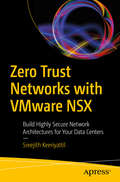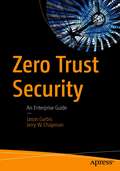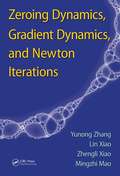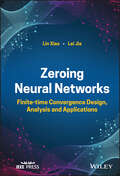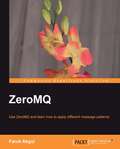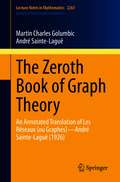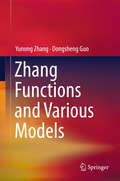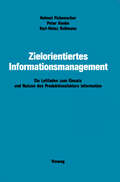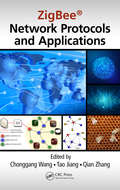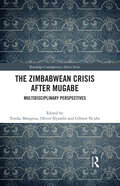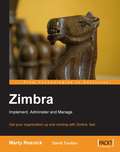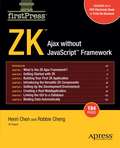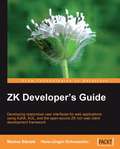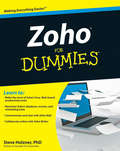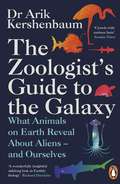- Table View
- List View
Zero Trust Networks with VMware NSX: Build Highly Secure Network Architectures for Your Data Centers
by Sreejith KeeriyattilSecure your VMware infrastructure against distrusted networks using VMware NSX. This book shows you why current security firewall architecture cannot protect against new threats to your network and how to build a secure architecture for your data center.Author Sreerjith Keeriyattil teaches you how micro-segmentation can be used to protect east-west traffic. Insight is provided into working with Service Composer and using NSX REST API to automate firewalls. You will analyze flow and security threats to monitor firewalls using VMware Log and see how Packet Flow works with VMware NSX micro-segmentation. The information presented in Zero Trust Networks with VMware NSX allows you to study numerous attack scenarios and strategies to stop these attacks, and know how VMware Air Watch can further improve your architecture.What You Will LearnKnow how micro-segmentation works and its benefitsImplement VMware-distributed firewallsAutomate security policies Integrate IPS/IDS with VMware NSXAnalyze your firewall's configurations, rules, and policiesWho This Book Is ForExperienced VMware administrators and security administrators who have an understanding of data center architecture and operations
Zero Trust Overview and Playbook Introduction: Guidance for business, security, and technology leaders and practitioners
by Mark Simos Nikhil KumarEnhance your cybersecurity and agility with this thorough playbook, featuring actionable guidance, insights, and success criteria from industry expertsKey FeaturesGet simple, clear, and practical advice for everyone from CEOs to security operationsOrganize your Zero Trust journey into role-by-role execution stagesIntegrate real-world implementation experience with global Zero Trust standardsPurchase of the print or Kindle book includes a free eBook in the PDF formatBook DescriptionZero Trust is cybersecurity for the digital era and cloud computing, protecting business assets anywhere on any network. By going beyond traditional network perimeter approaches to security, Zero Trust helps you keep up with ever-evolving threats. The playbook series provides simple, clear, and actionable guidance that fully answers your questions on Zero Trust using current threats, real-world implementation experiences, and open global standards. The Zero Trust playbook series guides you with specific role-by-role actionable information for planning, executing, and operating Zero Trust from the boardroom to technical reality. This first book in the series helps you understand what Zero Trust is, why it’s important for you, and what success looks like. You’ll learn about the driving forces behind Zero Trust – security threats, digital and cloud transformations, business disruptions, business resilience, agility, and adaptability. The six-stage playbook process and real-world examples will guide you through cultural, technical, and other critical elements for success. By the end of this book, you’ll have understood how to start and run your Zero Trust journey with clarity and confidence using this one-of-a-kind series that answers the why, what, and how of Zero Trust!What you will learnFind out what Zero Trust is and what it means to youUncover how Zero Trust helps with ransomware, breaches, and other attacksUnderstand which business assets to secure firstUse a standards-based approach for Zero TrustSee how Zero Trust links business, security, risk, and technologyUse the six-stage process to guide your Zero Trust journeyTransform roles and secure operations with Zero TrustDiscover how the playbook guides each role to successWho this book is forWhether you’re a business leader, security practitioner, or technology executive, this comprehensive guide to Zero Trust has something for you. This book provides practical guidance for implementing and managing a Zero Trust strategy and its impact on every role (including yours!). This is the go-to guide for everyone including board members, CEOs, CIOs, CISOs, architects, engineers, IT admins, security analysts, program managers, product owners, developers, and managers. Don't miss out on this essential resource for securing your organization against cyber threats.
Zero Trust Security: An Enterprise Guide
by Jason Garbis Jerry W. ChapmanUnderstand how Zero Trust security can and should integrate into your organization. This book covers the complexity of enterprise environments and provides the realistic guidance and requirements your security team needs to successfully plan and execute a journey to Zero Trust while getting more value from your existing enterprise security architecture. After reading this book, you will be ready to design a credible and defensible Zero Trust security architecture for your organization and implement a step-wise journey that delivers significantly improved security and streamlined operations.Zero Trust security has become a major industry trend, and yet there still is uncertainty about what it means. Zero Trust is about fundamentally changing the underlying philosophy and approach to enterprise security—moving from outdated and demonstrably ineffective perimeter-centric approaches to a dynamic, identity-centric, and policy-based approach.Making this type of shift can be challenging. Your organization has already deployed and operationalized enterprise security assets such as Directories, IAM systems, IDS/IPS, and SIEM, and changing things can be difficult. Zero Trust Security uniquely covers the breadth of enterprise security and IT architectures, providing substantive architectural guidance and technical analysis with the goal of accelerating your organization‘s journey to Zero Trust. What You Will Learn Understand Zero Trust security principles and why it is critical to adopt themSee the security and operational benefits of Zero TrustMake informed decisions about where, when, and how to apply Zero Trust security architecturesDiscover how the journey to Zero Trust will impact your enterprise and security architectureBe ready to plan your journey toward Zero Trust, while identifying projects that can deliver immediate security benefits for your organization Who This Book Is ForSecurity leaders, architects, and practitioners plus CISOs, enterprise security architects, security engineers, network security architects, solution architects, and Zero Trust strategists
Zero Trust Sicherheit: Ein Leitfaden für Unternehmen
by Jason Garbis Jerry W. ChapmanVerstehen Sie, wie Zero-Trust-Sicherheit in Ihr Unternehmen integriert werden kann und sollte.Dieses Buch deckt die Komplexität von Unternehmensumgebungen ab und liefert die realistischen Anleitungen und Anforderungen, die Ihr Sicherheitsteam benötigt, um eine Reise zu Zero Trust erfolgreich zu planen und auszuführen und gleichzeitig mehr Wert aus Ihrer bestehenden Unternehmenssicherheitsarchitektur zu ziehen.Nach der Lektüre dieses Buches werden Sie in der Lage sein, eine glaubwürdige und vertretbare Zero-Trust-Sicherheitsarchitektur für Ihr Unternehmen zu entwerfen und eine schrittweise Umstellung zu implementieren, die zu deutlich verbesserter Sicherheit und optimierten Abläufen führt.Zero Trust Sicherheit hat sich zu einem wichtigen Branchentrend entwickelt, und dennoch herrscht immer noch Unsicherheit darüber, was es bedeutet.Bei Zero Trust geht es darum, die zugrundeliegende Philosophie und den Ansatz für die Unternehmenssicherheit grundlegend zu ändern - weg von veralteten und nachweislich ineffektiven perimeterzentrierten Ansätzen hin zu einem dynamischen, identitätszentrierten und richtlinienbasierten Ansatz.Diese Art von Umstellung kann eine Herausforderung sein. Ihr Unternehmen hat bereits Sicherheitsressourcen wie Verzeichnisse, IAM-Systeme, IDS/IPS und SIEM implementiert und in Betrieb genommen, und es kann schwierig sein, dies zu ändern. Zero Trust Sicherheit deckt die gesamte Bandbreite der Unternehmenssicherheit und IT-Architekturen ab und bietet fundierte architektonische Anleitungen und technische Analysen mit dem Ziel, den Weg Ihres Unternehmens zu Zero Trust zu beschleunigen.Was Sie lernen werdenSie verstehen die Sicherheitsprinzipien von Zero Trust und warum es wichtig ist, diese zu übernehmenErkennen der Sicherheits- und Betriebsvorteile von Zero TrustTreffen Sie fundierte Entscheidungen darüber, wo, wann und wie Sie Zero Trust Sicherheitsarchitekturen einsetzenEntdecken Sie, wie sich der Weg zu Zero Trust auf Ihr Unternehmen und Ihre Sicherheitsarchitektur auswirken wirdSie sind in der Lage, Ihre Reise in Richtung Zero Trust zu planen und gleichzeitig Projekte zu identifizieren, die Ihrem Unternehmen unmittelbare Sicherheitsvorteile bringen können.Für wen ist dieses Buch gedacht?Sicherheitsverantwortliche, -architekten und -praktiker sowie CISOs, Sicherheitsarchitekten in Unternehmen, Sicherheitsingenieure, Netzwerksicherheitsarchitekten, Lösungsarchitekten und Zero-Trust-Strategen
Zeroing Dynamics, Gradient Dynamics, and Newton Iterations
by Yunong Zhang Lin Xiao Zhengli Xiao Mingzhi MaoNeural networks and neural dynamics are powerful approaches for the online solution of mathematical problems arising in many areas of science, engineering, and business. Compared with conventional gradient neural networks that only deal with static problems of constant coefficient matrices and vectors, the authors’ new method called zeroing dynamics solves time-varying problems. Zeroing Dynamics, Gradient Dynamics, and Newton Iterations is the first book that shows how to accurately and efficiently solve time-varying problems in real-time or online using continuous- or discrete-time zeroing dynamics. The book brings together research in the developing fields of neural networks, neural dynamics, computer mathematics, numerical algorithms, time-varying computation and optimization, simulation and modeling, analog and digital hardware, and fractals. The authors provide a comprehensive treatment of the theory of both static and dynamic neural networks. Readers will discover how novel theoretical results have been successfully applied to many practical problems. The authors develop, analyze, model, simulate, and compare zeroing dynamics models for the online solution of numerous time-varying problems, such as root finding, nonlinear equation solving, matrix inversion, matrix square root finding, quadratic optimization, and inequality solving.
Zeroing Neural Networks: Finite-time Convergence Design, Analysis and Applications
by Lin Xiao Lei JiaZeroing Neural Networks Describes the theoretical and practical aspects of finite-time ZNN methods for solving an array of computational problems Zeroing Neural Networks (ZNN) have become essential tools for solving discretized sensor-driven time-varying matrix problems in engineering, control theory, and on-chip applications for robots. Building on the original ZNN model, finite-time zeroing neural networks (FTZNN) enable efficient, accurate, and predictive real-time computations. Setting up discretized FTZNN algorithms for different time-varying matrix problems requires distinct steps. Zeroing Neural Networks provides in-depth information on the finite-time convergence of ZNN models in solving computational problems. Divided into eight parts, this comprehensive resource covers modeling methods, theoretical analysis, computer simulations, nonlinear activation functions, and more. Each part focuses on a specific type of time-varying computational problem, such as the application of FTZNN to the Lyapunov equation, linear matrix equation, and matrix inversion. Throughout the book, tables explain the performance of different models, while numerous illustrative examples clarify the advantages of each FTZNN method. In addition, the book: Describes how to design, analyze, and apply FTZNN models for solving computational problems Presents multiple FTZNN models for solving time-varying computational problems Details the noise-tolerance of FTZNN models to maximize the adaptability of FTZNN models to complex environments Includes an introduction, problem description, design scheme, theoretical analysis, illustrative verification, application, and summary in every chapter Zeroing Neural Networks: Finite-time Convergence Design, Analysis and Applications is an essential resource for scientists, researchers, academic lecturers, and postgraduates in the field, as well as a valuable reference for engineers and other practitioners working in neurocomputing and intelligent control.
Zeroing Neural Networks: Finite-time Convergence Design, Analysis and Applications
by Lin Xiao Lei JiaZeroing Neural Networks Describes the theoretical and practical aspects of finite-time ZNN methods for solving an array of computational problems Zeroing Neural Networks (ZNN) have become essential tools for solving discretized sensor-driven time-varying matrix problems in engineering, control theory, and on-chip applications for robots. Building on the original ZNN model, finite-time zeroing neural networks (FTZNN) enable efficient, accurate, and predictive real-time computations. Setting up discretized FTZNN algorithms for different time-varying matrix problems requires distinct steps. Zeroing Neural Networks provides in-depth information on the finite-time convergence of ZNN models in solving computational problems. Divided into eight parts, this comprehensive resource covers modeling methods, theoretical analysis, computer simulations, nonlinear activation functions, and more. Each part focuses on a specific type of time-varying computational problem, such as the application of FTZNN to the Lyapunov equation, linear matrix equation, and matrix inversion. Throughout the book, tables explain the performance of different models, while numerous illustrative examples clarify the advantages of each FTZNN method. In addition, the book: Describes how to design, analyze, and apply FTZNN models for solving computational problems Presents multiple FTZNN models for solving time-varying computational problems Details the noise-tolerance of FTZNN models to maximize the adaptability of FTZNN models to complex environments Includes an introduction, problem description, design scheme, theoretical analysis, illustrative verification, application, and summary in every chapter Zeroing Neural Networks: Finite-time Convergence Design, Analysis and Applications is an essential resource for scientists, researchers, academic lecturers, and postgraduates in the field, as well as a valuable reference for engineers and other practitioners working in neurocomputing and intelligent control.
ZeroMQ
by Faruk AkgulA practical, step-by-step example-rich tutorial. If you are a C developer who wants to learn about ZeroMQ, this book is for you. It is assumed that the reader has C experience at some level but prior ZeroMQ knowledge is not expected.
The Zeroth Book of Graph Theory: An Annotated Translation of Les Réseaux (ou Graphes)—André Sainte-Laguë (1926) (Lecture Notes in Mathematics #2261)
by Martin Charles Golumbic André Sainte-LaguëMarking 94 years since its first appearance, this book provides an annotated translation of Sainte-Laguë's seminal monograph Les réseaux (ou graphes), drawing attention to its fundamental principles and ideas. Sainte-Laguë's 1926 monograph appeared only in French, but in the 1990s H. Gropp published a number of English papers describing several aspects of the book. He expressed his hope that an English translation might sometime be available to the mathematics community. In the 10 years following the appearance of Les réseaux (ou graphes), the development of graph theory continued, culminating in the publication of the first full book on the theory of finite and infinite graphs in 1936 by Dénes König. This remained the only well-known text until Claude Berge's 1958 book on the theory and applications of graphs. By 1960, graph theory had emerged as a significant mathematical discipline of its own. This book will be of interest to graph theorists and mathematical historians.
Zhang Functions and Various Models
by Yunong Zhang Dongsheng GuoThis book focuses on solving different types of time-varying problems. It presents various Zhang dynamics (ZD) models by defining various Zhang functions (ZFs) in real and complex domains. It then provides theoretical analyses of such ZD models and illustrates their results. It also uses simulations to substantiate their efficacy and show the feasibility of the presented ZD approach (i.e., different ZFs leading to different ZD models), which is further applied to the repetitive motion planning (RMP) of redundant robots, showing its application potential.
Zhang Time Discretization (ZTD) Formulas and Applications
by Yunong Zhang Jinjin GuoThis book aims to solve the discrete implementation problems of continuous-time neural network models while improving the performance of neural networks by using various Zhang Time Discretization (ZTD) formulas.The authors summarize and present the systematic derivations and complete research of ZTD formulas from special 3S-ZTD formulas to general NS-ZTD formulas. These finally lead to their proposed discrete-time Zhang neural network (DTZNN) algorithms, which are more efficient, accurate, and elegant. This book will open the door to scientific and engineering applications of ZTD formulas and neural networks, and will be a major inspiration for studies in neural network modeling, numerical algorithm design, prediction, and robot manipulator control.The book will benefit engineers, senior undergraduates, graduate students, and researchers in the fields of neural networks, computer mathematics, computer science, artificial intelligence, numerical algorithms, optimization, robotics, and simulation modeling.
Zhang Time Discretization (ZTD) Formulas and Applications
by Yunong Zhang Jinjin GuoThis book aims to solve the discrete implementation problems of continuous-time neural network models while improving the performance of neural networks by using various Zhang Time Discretization (ZTD) formulas.The authors summarize and present the systematic derivations and complete research of ZTD formulas from special 3S-ZTD formulas to general NS-ZTD formulas. These finally lead to their proposed discrete-time Zhang neural network (DTZNN) algorithms, which are more efficient, accurate, and elegant. This book will open the door to scientific and engineering applications of ZTD formulas and neural networks, and will be a major inspiration for studies in neural network modeling, numerical algorithm design, prediction, and robot manipulator control.The book will benefit engineers, senior undergraduates, graduate students, and researchers in the fields of neural networks, computer mathematics, computer science, artificial intelligence, numerical algorithms, optimization, robotics, and simulation modeling.
Zielorientiertes Informationsmanagement: Ein Leitfaden zum Einsatz und Nutzen des Produktionsfaktors Information
by Helmut Fickenscher Peter Hanke Karl-Heinz KollmannZigBee Network Protocols and Applications
Compared with other wireless communication technologies, such as Bluetooth, WiFi, and UWB, ZigBee is a far more reliable, affordable, and energy-efficient option. It is also the only global wireless communication standard for easily deployed, low-power consumption products.ZigBee Network Protocols and Applications provides detailed descriptions of
The Zimbabwean Crisis after Mugabe: Multidisciplinary Perspectives (Routledge Contemporary Africa)
by Tendai MangenaThis book examines the ways in which political discourses of crisis and ‘newness’ are (re)produced, circulated, naturalised, received and contested in Post-Mugabe Zimbabwe. Going beyond the ordinariness of conventional political, human and social science methods, the book offers new and engaging multi-disciplinary approaches that treat discourse and language as important sites to encounter the politics of contested representations of the Zimbabwean crisis in the wake of the 2017 coup. The book centres discourse on new approaches to contestations around the discursive framing of various aspects of the socio-economic and political crisis related to significant political changes in Zimbabwe post-2017. Contributors in this volume, most of whom experienced the complex transition first-hand, examine some of the ways in which language functions as a socio-cultural and political mechanism for creating imaginaries, circulating, defending and contesting conceptions, visions, perceptions and knowledges of the post-Mugabe turn in the Zimbabwean crisis and its management by the "New Dispensation". This book will be of interest to scholars of African studies, postcolonial studies, language/discourse studies, African politics and culture.
The Zimbabwean Crisis after Mugabe: Multidisciplinary Perspectives (Routledge Contemporary Africa)
by Tendai Mangena Oliver Nyambi Gibson NcubeThis book examines the ways in which political discourses of crisis and ‘newness’ are (re)produced, circulated, naturalised, received and contested in Post-Mugabe Zimbabwe. Going beyond the ordinariness of conventional political, human and social science methods, the book offers new and engaging multi-disciplinary approaches that treat discourse and language as important sites to encounter the politics of contested representations of the Zimbabwean crisis in the wake of the 2017 coup. The book centres discourse on new approaches to contestations around the discursive framing of various aspects of the socio-economic and political crisis related to significant political changes in Zimbabwe post-2017. Contributors in this volume, most of whom experienced the complex transition first-hand, examine some of the ways in which language functions as a socio-cultural and political mechanism for creating imaginaries, circulating, defending and contesting conceptions, visions, perceptions and knowledges of the post-Mugabe turn in the Zimbabwean crisis and its management by the "New Dispensation". This book will be of interest to scholars of African studies, postcolonial studies, language/discourse studies, African politics and culture.
Zimbra: Implement, Administer And Manage; Get Your Organization Up And Running With Zimbra, Fast
by Joshue O ConnorThis book is a fast and easy read, taking the reader from the inception of an idea, to a fully working cash-generating website built on Joomla! This book is suitable for business people with a medium level of technical skill who need a good primer on how to implement a cash-generating website. Those unfamiliar with Joomla! Would benefit from reading Building Websites with Joomla! 1.5 Beta 1.
Zip Drive and Disk (large print)
by RnibThis page shows images of a Zip disk and a Zip drive. They are separated by a thin vertical line. There is a locator dot shown, which will be at the top left of the page when the image is the right way up. On the left is a top view of a Zip disk and to the right is a drive viewed from the top. Zip disk: This top view of a disk shows a cover at the top of the image. It slides to the left to give access to the magnetic disk inside the casing. There is a label at the bottom for listing the contents of the disk. Zip drive: On the right of the page is an image of the drive seen from the top. At the top of the image is the casing of the drive. Down the page is a clear window with part of a disk visible through it. At the bottom of the page is the remaining portion of the disk with an arrow to the left of it to show the disk being inserted. To the right of the disk are two indicator lights and an eject button. On the right hand edge of the image, at the top and bottom, are two rubber feet to stand the drive on.
Zip Drive and Disk (UEB contracted)
by RnibThis page shows images of a Zip disk and a Zip drive. They are separated by a thin vertical line. There is a locator dot shown, which will be at the top left of the page when the image is the right way up. On the left is a top view of a Zip disk and to the right is a drive viewed from the top. Zip disk: This top view of a disk shows a cover at the top of the image. It slides to the left to give access to the magnetic disk inside the casing. There is a label at the bottom for listing the contents of the disk. Zip drive: On the right of the page is an image of the drive seen from the top. At the top of the image is the casing of the drive. Down the page is a clear window with part of a disk visible through it. At the bottom of the page is the remaining portion of the disk with an arrow to the left of it to show the disk being inserted. To the right of the disk are two indicator lights and an eject button. On the right hand edge of the image, at the top and bottom, are two rubber feet to stand the drive on.
Zip Drive and Disk (UEB uncontracted)
by RnibThis page shows images of a Zip disk and a Zip drive. They are separated by a thin vertical line. There is a locator dot shown, which will be at the top left of the page when the image is the right way up. On the left is a top view of a Zip disk and to the right is a drive viewed from the top. Zip disk: This top view of a disk shows a cover at the top of the image. It slides to the left to give access to the magnetic disk inside the casing. There is a label at the bottom for listing the contents of the disk. Zip drive: On the right of the page is an image of the drive seen from the top. At the top of the image is the casing of the drive. Down the page is a clear window with part of a disk visible through it. At the bottom of the page is the remaining portion of the disk with an arrow to the left of it to show the disk being inserted. To the right of the disk are two indicator lights and an eject button. On the right hand edge of the image, at the top and bottom, are two rubber feet to stand the drive on.
ZK: Ajax without the Javascript Framework
by Henri Chen Amy ChengThis book shows you how to use this simplest Ajax framework to write real world responsive web application, and it covers ZK's more than 70 XUL and 80 XHTML rich GUI components. This firstPress book (PDF eBook with Print on Demand (POD) option) is the first book on ZK. It is authoritatively written by the co-founder/lead of ZK project
ZK Developer's Guide: Developing Responsive User Interfaces For Web Applications Using Ajax, Xul, And The Open-source Zk Rich Web Client Development Framework
by Jurgen Schumacher Markus StaubleZK is an open-source web development framework that enables web applications to have the rich user experiences and low development costs that desktop applications have had for years. ZK includes an Ajax-based event-driven engine, rich sets of XML User Interface Language (XUL) and XHTML components, and a markup language. The ZK rich client framework takes the so-called server-centric approach: the content synchronization of components and the event pipelining between clients and servers are automatically done by the engine and Ajax plumbing codes are completely transparent to web application developers. Therefore, the end users get rich user interfaces with similar engaged interactivity and responsiveness to that of desktop applications, while for programmers, development remains similar in simplicity to that of desktop applications. This book is a Developer's Guide that steps you through the ZK framework with examples. It starts with installing and configuring ZK and takes you on to integrate it with other frameworks. By the time you are through the book you will be able to build an application on your own.
Zoho For Dummies
by Steve HolznerA great way to get started on this new, FREE, Web-based productivity and collaboration tool Zoho is a very cool-and free-alternative to Microsoft Office. Known as "cloud" computing because it's totally Web-based, Zoho provides 18 different applications to help you write documents, create spreadsheets, send e-mail, and much more. People love it, but what it doesn't offer are extensive help files, so that's where this practical book comes in. Zoho For Dummies shows you how to use Zoho's most widely used applications, including Zoho Writer, Zoho Notebook, Zoho Show, Zoho Sheet, Zoho DB, Zoho Mail, Zoho Planner, Zoho CRM, and Zoho Projects. You'll get thoroughly up to speed on all common tasks and discover enough tips and tricks to get you power-using Zoho in no time. Zoho is a free, Web-based alternative to Microsoft Office launched in 2007; it is considered to be "cloud computing" because it is categorized as Software as a Service (SaaS) and Web-based The book guides you through common tasks and provides tips and tricks to maximize your productivity and minimize hassle Covers Zoho Writer, Zoho Notebook, Zoho Show, Zoho Sheet, Zoho DB, Zoho Mail, Zoho Planner, Zoho CRM, and Zoho Projects Also provides information about sharing content, scheduling, and more Get your head in the clouds with this friendly guide to the exciting new Zoho "cloud" alternative to Microsoft Office.
Zoho For Dummies
by Steve HolznerA great way to get started on this new, FREE, Web-based productivity and collaboration tool Zoho is a very cool-and free-alternative to Microsoft Office. Known as "cloud" computing because it's totally Web-based, Zoho provides 18 different applications to help you write documents, create spreadsheets, send e-mail, and much more. People love it, but what it doesn't offer are extensive help files, so that's where this practical book comes in. Zoho For Dummies shows you how to use Zoho's most widely used applications, including Zoho Writer, Zoho Notebook, Zoho Show, Zoho Sheet, Zoho DB, Zoho Mail, Zoho Planner, Zoho CRM, and Zoho Projects. You'll get thoroughly up to speed on all common tasks and discover enough tips and tricks to get you power-using Zoho in no time. Zoho is a free, Web-based alternative to Microsoft Office launched in 2007; it is considered to be "cloud computing" because it is categorized as Software as a Service (SaaS) and Web-based The book guides you through common tasks and provides tips and tricks to maximize your productivity and minimize hassle Covers Zoho Writer, Zoho Notebook, Zoho Show, Zoho Sheet, Zoho DB, Zoho Mail, Zoho Planner, Zoho CRM, and Zoho Projects Also provides information about sharing content, scheduling, and more Get your head in the clouds with this friendly guide to the exciting new Zoho "cloud" alternative to Microsoft Office.
The Zoologist's Guide to the Galaxy: What Animals on Earth Reveal about Aliens – and Ourselves
by Arik KershenbaumDISCOVER HOW LIFE REALLY WORKS - ON EARTH AND IN SPACEWe are unprepared for the greatest discovery of modern science - aliens. Scientists are confident that there is life across the universe, yet we have not moved beyond Hollywood stereotypes. The time has come to abandon our fixation on alien monsters and to look at the science.Using his expert understanding of life on Earth and Darwin's theory of evolution Cambridge zoologist Dr Arik Kershenbaum explains what alien life must be like: how these creatures will move, socialise and communicate.Might there be an alien planet with supersonic animals? Will aliens scream with fear, act honestly or have technology? Is the universe swarming with robots? Dr Kershenbaum uses cutting-edge science to paint an entertaining and compelling picture of extra-terrestrial life. These are aliens - but not as you know them.
